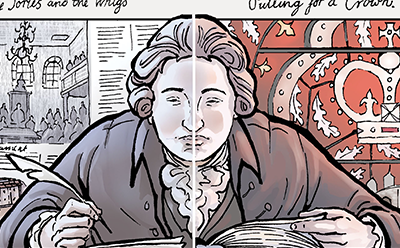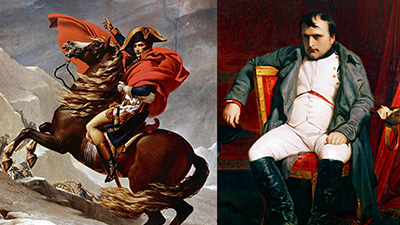Atlantic Revolutions
Driving Question: How was the period from 1750 to 1825 an “age of revolution”?
What does it take to drive a society toward revolution? Beginning in the late eighteenth century, revolutionary movements swept across the Atlantic Ocean and turned the world upside down.
Learning Objectives:
- Identify the conditions that led to revolutions in the Atlantic world.
- Use the historical thinking skill of causation to evaluate the causes and effects of the American, French, Haitian, and Latin American revolutions.
- Use a graphic biography to support, extend, or challenge the overarching narratives of this period.
Vocab Terms:
- conservative
- egalitarian
- exploitation
- liberal
- nobility
- peasant
- the Enlightenment
Opener: Atlantic Revolutions
To teach this lesson step, refer to page 2 of the Lesson 2.4 Teaching Guide.
Consider using Three-Step Reading with students to “read” visuals: First, get the big picture. Then, zoom in on details. Finally, think about what the image means. Page 3 of our Reading Guide spells it out.
In this lesson, you’ll learn about political and social upheavals that swept the world. This activity will get you thinking about the impacts of the Age of Revolution.
Visual Vote: Atlantic Revolutions
The Two Faces of Revolution
To teach this lesson step, refer to page 3 of the Lesson 2.4 Teaching Guide.
We have a Three-Step Reading Tool just for Graphic Bios. Use it to guide your students to observe, understand, and connect.
The Age of Revolution was complicated, and so were the people who participated. This graphic biography explores the duality of British thinker Edmund Burke.
-
Guiding Questions
-
Before you read
Preview the questions below, and then skim the comic, paying attention to things like prominent colors, shapes, and types of text and fonts. How do you know where to start and in which direction to read? What’s in the gutters (the space between panels)? Who or what is the focus of the comic?
While you read
- When and where was Edmund Burke born? Who ruled the place where he was born?
- What was the major political contest in Britain during this period? What did each side believe?
- In what ways was Burke a liberal? In what ways was he a conservative?
- What were the events that made Burke fear too rapid change and too much democracy?
- How does the artist use art and design to demonstrate Burke’s position as both a liberal and a conservative?
After you read
Respond to this question: How could the rise of liberalism in this period also lead to the rise of political conservatism?
American, French, Haitian, and Latin American Revolutions
To teach this lesson step, refer to page 4 of the Lesson 2.4 Teaching Guide.
As students identify causes of revolutions and build their recipe for a revolution, you may want to differentiate for some learners. We’ve got ideas to support all learners in our Differentiation Guide.
Beginning in the late eighteenth century, a revolutionary wave swept the Atlantic Ocean, overturning old governments and ushering in new ideas about freedom.
-
Guiding Questions
-
Before you read
Preview the questions below, and then skim the article. Be sure to look at the section headings and any images.
While you read
Look for answers to these questions:
- How did the Seven Years’ War help to lead to both the American and French Revolutions?
- What were the results of the American Revolution in terms of achieving independence and creating an egalitarian society?
- How did the French Revolution transform France?
- Why was the Haitian Revolution the most radical of them all?
- What fears led to internal divisions within the Latin American revolutions?
After you read
Respond to these questions: What sort of things can political revolutions change? Are there any limits on the changes these sorts of revolutions can bring? Why or why not?
Closer: Atlantic Revolutions
To teach this lesson step, refer to page 6 of the Lesson 2.4 Teaching Guide.
In this closing activity, consider all you’ve learned as you make your own claim about the so-called Age of Revolution.
Napoleon: Tyrant or Revolutionary?
To teach this lesson step, refer to page 6 of the Lesson 2.4 Teaching Guide.
The revolutions that swept the Atlantic world may have been idealistic at the start. But in many cases, things got messy. Few revolutionary figures illustrate this better than Napoleon Bonaparte.
-
Guiding Questions
-
Before you read
Preview the questions below, and then skim the article. Be sure to look at the section headings and any images.
While you read
Look for answers to these questions:
- How did Napoleon rise to power so quickly?
- How did Napoleon become emperor?
- What decision led to Napoleon’s downfall?
- What evidence suggests we should see Napoleon as liberator?
- What evidence suggests we should see Napoleon as tyrant?
After you read
Respond to the question: To what extent did Napoleon Bonaparte’s actions align with or contradict the principles of the French Revolution?













